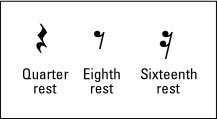>
Figure 1: Wearing more than one hat.
These hats, er, rests always hang in the same positions on both staves, making it easy for you to spot them in the music. A half rest sits on the middle line, while a whole rest hangs from the fourth line up, shown in Figure 2.
>

>
Figure 2: Hanging your hat.
To see whole and half rests in action, take a peek at Figure 3. In the first measure of Figure 3, you play the two A quarter notes, and then the half rest tells you not to play anything for the next two beats. In the next measure, the whole rest tells you that you're off duty — you rest for four beats. In the third measure, you put down your donut and play two G quarter notes, two beats of rest, and finally, the whole show ends in the next measure with a whole note A.
>

>
Figure 3: Rocking and resting.
Quarter rests and more
Composers also use rests to tell you to stop playing for the equivalent of quarter notes, eighth notes, and sixteenth notes. Figure 4 shows you the musical squigglies that correspond to each of these resting periods.
>

>
Figure 4: Quarter, eighth, and sixteenth rests.
Think of the quarter rest as an uncomfortable-looking chair. Because it's uncomfortable, you won't rest too long. In fact, you don't rest any longer than one beat in this chair.
The eighth rest and sixteenth rest are easy to recognize: They have the same number of "flags" — although slightly different in fashion — as their note counterparts. An eighth note and eighth rest each have one flag. Sixteenth notes and rests have two flags.
Quarter rests are easy to count — they last only one beat. Eighth rests are a bit harder to count simply because they happen faster. When you play eighth rests, count out loud "1-and, 2-and," and so on. Doing so helps you place the eighth rests more precisely, and may even cause others to sing along.
Figure 5 gives you a chance to count out some quarter and eighth rests.
>

>
Figure 5: Counting smaller rests.
Sixteenth notes also have a corresponding rest, but these are very tricky to play, except at very slow tempos. Until you get into more advanced music, you really don't need to know much more about these rests than what they look like (refer to Figure 4).
>
dummies
Source:http://www.dummies.com/how-to/content/examining-rests-in-musical-notation.html
No comments:
Post a Comment